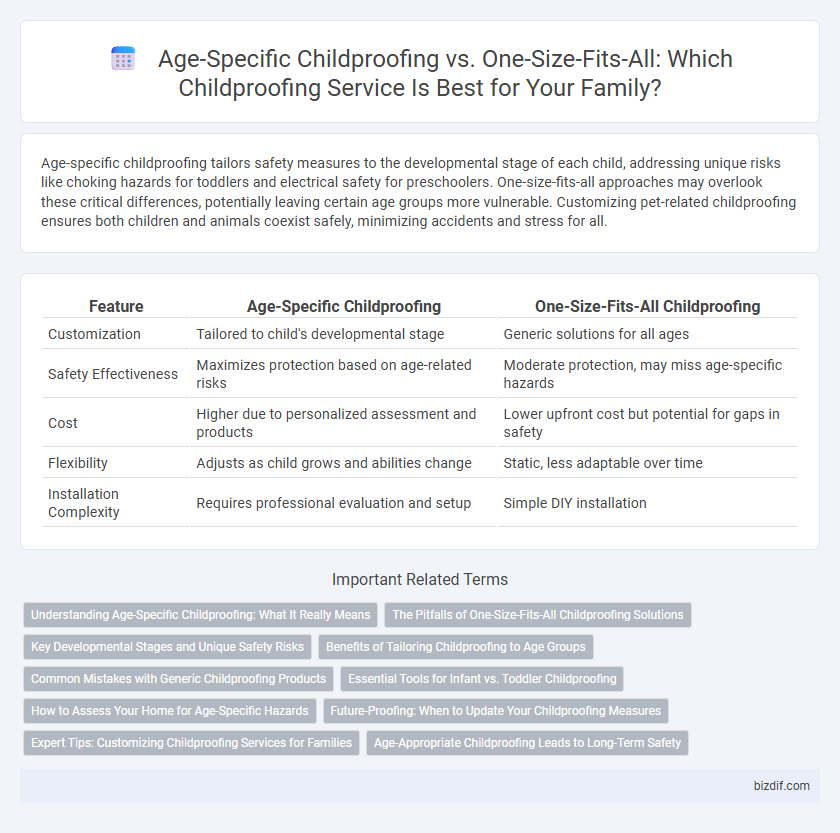Age-specific childproofing tailors safety measures to the developmental stage of each child, addressing unique risks like choking hazards for toddlers and electrical safety for preschoolers. One-size-fits-all approaches may overlook these critical differences, potentially leaving certain age groups more vulnerable. Customizing pet-related childproofing ensures both children and animals coexist safely, minimizing accidents and stress for all.
Table of Comparison
| Feature | Age-Specific Childproofing | One-Size-Fits-All Childproofing |
|---|---|---|
| Customization | Tailored to child's developmental stage | Generic solutions for all ages |
| Safety Effectiveness | Maximizes protection based on age-related risks | Moderate protection, may miss age-specific hazards |
| Cost | Higher due to personalized assessment and products | Lower upfront cost but potential for gaps in safety |
| Flexibility | Adjusts as child grows and abilities change | Static, less adaptable over time |
| Installation Complexity | Requires professional evaluation and setup | Simple DIY installation |
Understanding Age-Specific Childproofing: What It Really Means
Age-specific childproofing tailors safety measures to the developmental stages and unique behaviors of children, ensuring protection that adapts as they grow. Unlike one-size-fits-all solutions, it addresses age-relevant risks such as choking hazards for toddlers and fall prevention for older children. Effective age-specific strategies reduce accidents by anticipating the evolving capabilities and curiosities of each age group.
The Pitfalls of One-Size-Fits-All Childproofing Solutions
One-size-fits-all childproofing solutions often fail to address the unique developmental stages and risks associated with different age groups, resulting in ineffective safety measures. For infants, hazards like choking and soft-edge protection are paramount, while toddlers require barriers for climbing and access restriction to dangerous items. Tailoring childproofing services to specific age-related needs ensures comprehensive home safety and minimizes potential injury risks.
Key Developmental Stages and Unique Safety Risks
Age-specific childproofing targets key developmental stages such as crawling, walking, and climbing, addressing unique safety risks like choking hazards for infants and stair falls for toddlers. Unlike one-size-fits-all solutions, customized safety measures adapt to evolving physical abilities and curiosity levels. This tailored approach ensures optimal protection by focusing on age-relevant dangers and promoting a secure environment through each growth phase.
Benefits of Tailoring Childproofing to Age Groups
Tailoring childproofing to specific age groups addresses unique developmental risks, ensuring safety measures align with the child's current abilities and behaviors. Customized solutions reduce hazards more effectively than one-size-fits-all approaches, minimizing choking, poisoning, or injury risks appropriate to each stage. Age-specific childproofing fosters a secure environment that adapts as children grow, promoting sustained protection and peace of mind for caregivers.
Common Mistakes with Generic Childproofing Products
Using generic childproofing products often overlooks critical age-specific safety needs, increasing the risk of accidents for toddlers and infants. Common mistakes include installing locks or gates too high for younger children or selecting outlet covers that are too easy to remove. Tailoring childproofing solutions to developmental stages ensures effective hazard prevention and enhances overall home safety.
Essential Tools for Infant vs. Toddler Childproofing
Infant childproofing requires essential tools such as outlet covers, corner guards, and cabinet locks designed to prevent access to choking hazards and sharp objects. Toddler childproofing focuses on securing furniture with anchors, installing stair gates, and using door knob covers to restrict access to dangerous areas while accommodating increased mobility and curiosity. Tailoring tools to specific age-related risks ensures effective safety measures for both infants and toddlers.
How to Assess Your Home for Age-Specific Hazards
Assess your home for age-specific hazards by evaluating areas where toddlers explore, such as low cabinets and reachable electrical outlets, which require tailored safety measures like cabinet locks and outlet covers. For infants, focus on crib safety, soft corner protectors, and securing heavy furniture to prevent tipping hazards. Regularly inspect your home environment as your child grows, adapting childproofing methods to match developmental milestones and emerging risks.
Future-Proofing: When to Update Your Childproofing Measures
Age-specific childproofing tailors safety measures to the developmental stages of children, ensuring optimal protection as they grow. One-size-fits-all approaches often fail to address evolving risks posed by increased mobility and curiosity, leading to potential hazards over time. Regularly updating childproofing measures based on age-specific milestones future-proofs your home against emerging dangers, maintaining a secure environment.
Expert Tips: Customizing Childproofing Services for Families
Tailoring childproofing services based on a child's developmental stage enhances safety and effectiveness by addressing unique risks, such as choking hazards for toddlers or electrical safety for preschoolers. Experts recommend conducting regular home assessments to update safety measures as children grow, ensuring continuous protection. Customized childproofing plans incorporate family routines and specific home layouts, maximizing both functionality and peace of mind.
Age-Appropriate Childproofing Leads to Long-Term Safety
Age-appropriate childproofing targets hazards specific to developmental stages, ensuring effective protection as children grow. Tailoring safety measures to age-specific risks reduces accidents and promotes continuous safety in the home environment. This approach outperforms one-size-fits-all solutions by addressing evolving needs and fostering long-term injury prevention.
Age-Specific Childproofing vs One-Size-Fits-All Infographic

 bizdif.com
bizdif.com